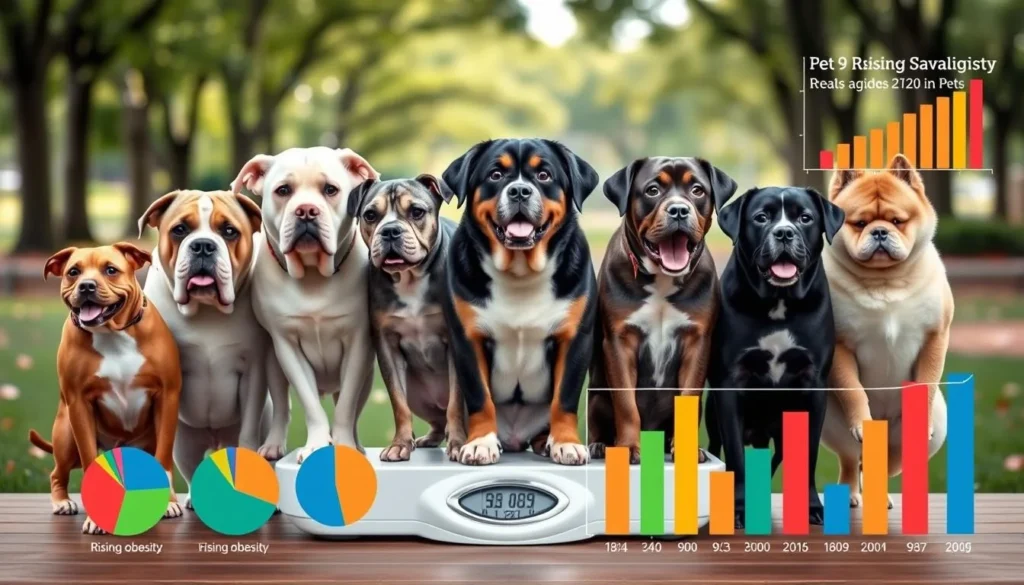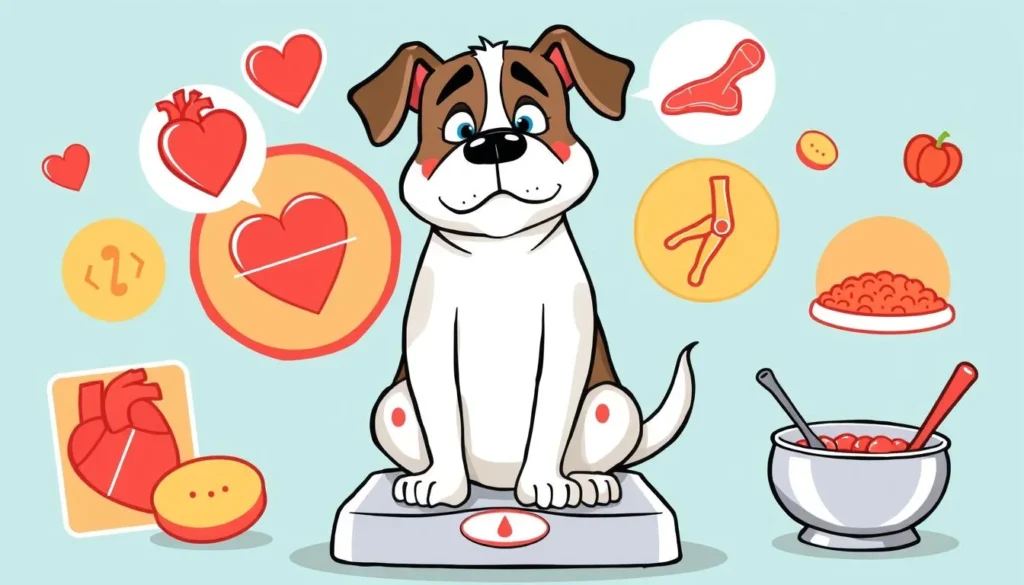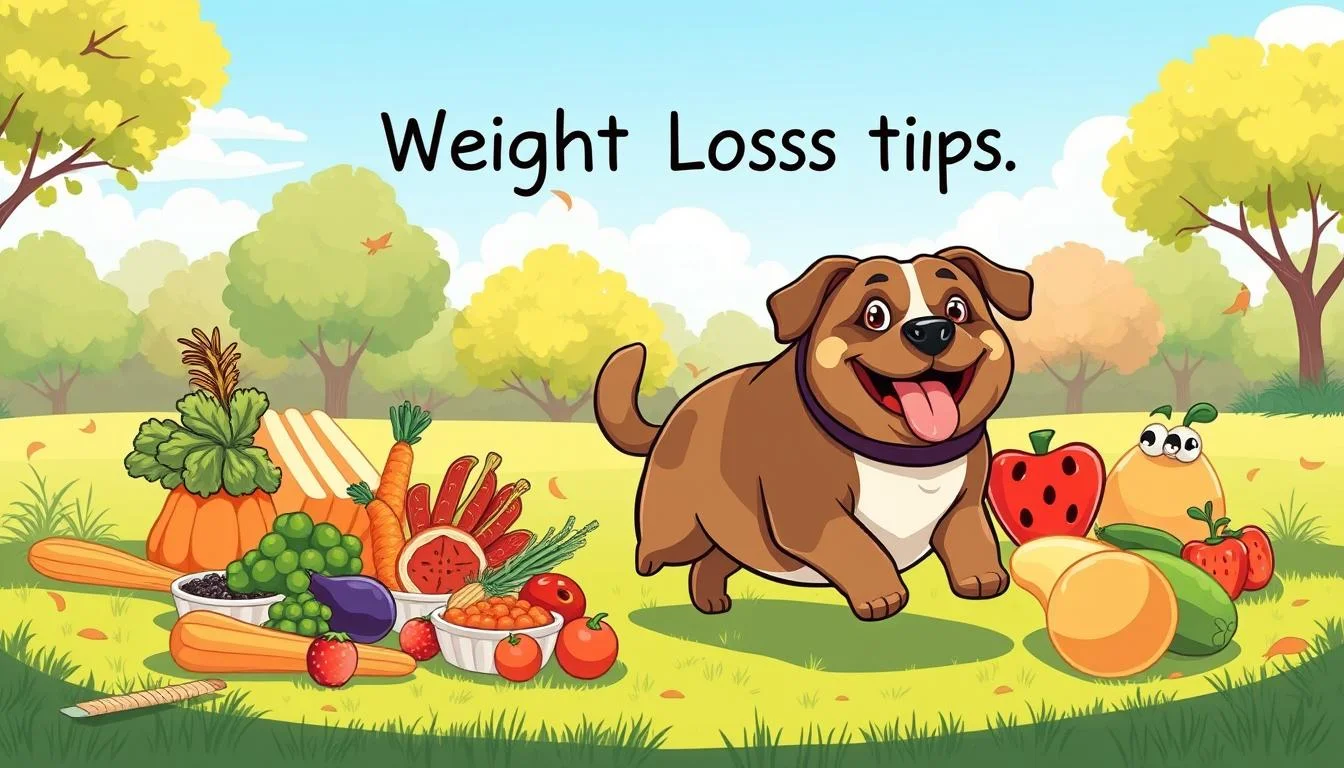Table of Contents
As a devoted pet parent, I remember the heartbreaking moment I realized my beloved Golden Retriever, Max, was struggling with his weight. His once-energetic bounds had become slow, labored steps, and I knew something had to change. Helping an obese canine lose weight is challenging, but it’s vital for their health and happiness.
The statistics are alarming. By 2022, nearly 59% of dogs in the United States were classified as overweight or obese. This isn’t just a cosmetic issue – excess weight can dramatically impact your fat dog’s quality of life, increasing risks of diabetes, joint problems, and potentially shortening their lifespan.
Understanding the root causes of canine obesity is the first step toward helping your furry friend reclaim their health. From overfeeding to lack of exercise, multiple factors contribute to weight gain in dogs. But with the right approach, you can help your obese canine transform their lifestyle and regain vitality.
Key Takeaways
- Over 59% of U.S. dogs are overweight or obese
- Excess weight significantly impacts canine health
- Personalized weight loss plans are vital
- Exercise and diet management are key to weight loss
- Veterinary guidance is essential for safe weight reduction
Understanding the Pet Obesity Crisis in America
The pet obesity crisis is a big health issue for dog owners in the U.S. Studies show that about 56% of dogs are overweight or obese. This is a big worry for their health and how long they’ll live.

The issue is more than just weight. The Association for Pet Obesity Prevention (APOP) found that nearly 50% of pet owners don’t see their dog’s weight problem. This lack of awareness makes it harder to help our pets.
Current Statistics and Trends
- 55.8% of dogs are classified as overweight or obese
- 20% of daily caloric intake comes from treats and table scraps
- Treats can range from 7 to 150 calories each
Impact on Canine Health and Longevity
An overweight pet faces many health risks, including:
- Increased risk of arthritis
- Higher likelihood of torn ligaments
- Potential heart and respiratory complications
- Reduced overall life expectancy
Common Causes of Weight Gain in Dogs
| Cause | Impact |
|---|---|
| Overfeeding | Excess calorie consumption |
| Lack of Exercise | Reduced metabolic rate |
| Human Food Sharing | High-fat diet introduction |
| Sedentary Lifestyle | Decreased physical activity |
“Clinical obesity is not just about appearance, but a serious medical condition that requires complete management.”
It’s important for pet owners to understand these trends. By spotting the signs early and taking action, you can help your dog stay healthy. This can prevent serious health problems.
Why Your Fat Dog Needs to Lose Weight Now

Your dog’s extra weight is more than just a look issue. It’s a big health risk. Studies show that 59% of U.S. dogs are overweight or obese. This puts them at high risk for many health problems.
Carrying extra weight is not just about looks. It can lead to serious health issues. These problems can make your dog’s life shorter and less enjoyable.
“Every pound matters when it comes to your dog’s health” – Veterinary Obesity Experts
- Increased risk of diabetes
- Higher likelihood of heart disease
- Potential joint and mobility problems
- Reduced life expectancy
Dogs are considered overweight if they are 15% over their ideal weight. They are obese if they are 30% over. This extra weight can cut a dog’s life short by up to two years. So, managing their weight is key for their long-term health.
| Weight Category | Health Impact | Lifespan Reduction |
|---|---|---|
| Overweight | Increased Health Risks | Up to 2 Years |
| Obese | Severe Health Complications | More Than 2 Years |
Acting now can stop serious health problems. It can help your dog live a happier, healthier life.
The Role of Veterinary Guidance in Weight Loss
Managing your plump pup’s weight loss needs a pro’s touch. Veterinarians are key in creating a safe, effective weight plan. It’s tailored to your dog’s health needs.
Getting help from a vet is vital for an overweight dog’s weight loss. Your vet will do a full check to make sure your dog’s weight loss is safe and works.
Initial Health Assessment
The first visit with your vet includes several important steps:
- Complete physical examination
- Blood work to check metabolic health
- Body Condition Score (BCS) measurement
- Screen for underlying health conditions
Setting Realistic Weight Loss Goals
Vets set weight loss goals based on your dog’s details. They look at weight, breed, age, and health.
| Weight Loss Parameter | Recommended Target |
|---|---|
| Weekly Weight Loss | 1-2% of body weight |
| Caloric Reduction | 20-30% fewer calories |
| Exercise Intensity | Gradually increasing activity |
Monitoring Progress Through Check-ups
Regular vet visits are key to tracking your dog’s weight loss. These visits help:
- Adjust diet plans
- Assess exercise effectiveness
- Detecting possible health issues
- Keep motivation up
“A veterinarian’s expertise is your greatest asset in helping your dog achieve a healthy weight.” – Canine Nutrition Expert
Remember, every plump pup’s weight loss journey is unique. Professional guidance ensures a safe, sustainable approach to improving your beefy buddy’s health and quality of life.
Choosing the Right Weight Management Diet
Managing your dog’s diet is important. With 59% of dogs in the U.S. being overweight, the right nutrition is key. It helps keep your pet healthy and long-lived.
When picking a diet for your rotund rover, look for these things:
- High protein content
- Low-fat formulation
- Increased fiber for satiety
- Essential nutrient preservation
“The right diet can transform your dog’s health and quality of life.”
Choose weight control foods that are balanced and help with weight loss. Nutro and Purina Pro Plan are good options for overweight dogs.
| Diet Characteristic | Benefit |
|---|---|
| Higher Fiber | Increases feeling of fullness |
| Lower Fat Content | Reduces caloric intake |
| Added L-carnitine | Supports fat metabolism |
Switch to new food gradually over 7-10 days to avoid digestive problems. Watch your dog’s weight and adjust food amounts as your vet suggests.
Weight management is a long-term effort. Be patient, consistent, and get professional advice. This will help your dog reach a healthier weight and enjoy a better life.
Portion Control and Feeding Schedule Strategies
Managing your fat dog’s diet needs careful planning. It’s important to control portions to prevent obesity. Many owners overfeed by guessing instead of measuring.
Measuring Food Accurately
Getting the right amount of food is key for weight control. Here are some tips for portioning:
- Invest in a digital kitchen scale for precise measurements
- Use standardized measuring cups for pet food
- Follow feeding guidelines for your dog’s ideal weight, not current weight
- Consult your veterinarian for personalized portion recommendations
Establishing Regular Meal Times
Regular meals help your dog’s metabolism and prevent overeating. Here are some tips:
- Feed your dog two to three measured meals daily
- Stick to consistent feeding times
- Remove uneaten food after 15-20 minutes
- Avoid late-night feedings
Avoiding Free Feeding Habits
“Free feeding can lead to uncontrolled weight gain and health issues for your fat dog.”
Stop free feeding by setting meal times. This controls calories and supports weight loss. Remember, each dog is different, so a vet’s advice is essential for managing weight.
Exercise Plans for Overweight Canines
Getting an overweight pet back into shape needs a careful plan. Your chunky pup needs an exercise plan that’s gentle and effective. It should build strength and burn calories without hurting them.
Begin with low-impact activities that fit your dog’s current fitness level. Walking is a great first step for overweight dogs. Start with 10-minute walks and slowly increase the time and effort.
“Movement is medicine for dogs – just like humans, regular exercise can transform their health and happiness.” – Veterinary Fitness Expert
- Swimming: A low-stress, full-body workout perfect for chunky pups
- Slow-paced walking on flat terrain
- Gentle fetch in a controlled environment
- Interactive games that encourage movement
For older or less active overweight pets, try these special exercises:
- Start with 5-minute sessions
- Use gentle, repetitive movements
- Monitor your dog’s breathing and energy levels
- Take frequent rest breaks
Always talk to your vet before starting any new exercise for your overweight pet. They can give advice that fits your dog’s health and fitness level.
Remember: Consistency is key in helping your chunky pup achieve a healthier weight and improved quality of life.
Smart Treat Choices and Reward Alternatives
Managing a hefty hound or portly pooch’s diet means picking the right treats. Treats can either help or hinder their weight loss. So, it’s key to choose wisely.
Finding the right dog treats requires thought. Opt for natural and low-calorie options. They support your pet’s health and keep their weight in check.
Healthy Treat Options
Here are some healthy treats for your furry friend:
- Dehydrated sweet potato slices
- Fresh apple chunks
- Blueberries
- Freeze-dried meat treats
Many pet owners now choose natural treats. These treats offer important nutrients without harmful additives. About 50% of dog owners prefer natural treats for their pet’s health.
Non-Food Rewards
Not all rewards have to be food. Your portly pooch might enjoy these non-food rewards:
- Extra playtime
- Belly rubs
- Fetch sessions
- Praise and attention
Managing Treat Portions
| Treat Brand | Calories per Treat | Suitability |
|---|---|---|
| Blue Buffalo Blue Bits | 4 calories | Excellent for training |
| Zuke’s Mini Naturals | 2 calories | Perfect for frequent rewards |
| SmartBones StickS | 55 calories | Moderate portion size |
Treats should only be a small part of your dog’s daily calories. Experts say treats should not be more than 10% of their daily calories.
“Treating your dog smartly is about quality, not quantity.” – Veterinary Nutritionist
By choosing the right treats, you can help your portly pooch stay healthy. And you can show them love and appreciation too.
Creating a Supportive Home Environment
Turning your home into a weight loss haven for your plump pup needs careful planning and family teamwork. Every family member is important in helping your beefy buddy stay healthy.
“A united family can make a significant difference in a dog’s weight loss success”
To create a healthy environment, follow these steps:
- Set clear rules for food access
- Keep high-calorie treats out of reach
- Teach everyone about your dog’s diet
- Choose specific spots for feeding
Stopping sneaky snacks is key for your pup’s weight control. Here are some tips:
- Keep your pup out of the kitchen when cooking
- Lock away human food in cabinets
- Use baby gates to block off areas
- Teach kids not to give table scraps
| Strategy | Impact |
|---|---|
| Controlled food environment | 40% reduction in unauthorized eating |
| Family nutrition education | 60% improved weight loss success |
| Consistent feeding schedule | 50% faster weight management |
By using these methods, your home becomes a supportive space for your pup’s weight loss. Staying consistent and working together is essential for lasting health gains.
Tracking Weight Loss Progress
It’s key to keep an eye on your rotund rover’s weight loss journey. This helps keep you motivated and ensures success. Tracking progress shows how your dog is doing with diet and exercise changes.
Weekly Weigh-ins: Your Roadmap to Success
Regular weigh-ins are vital for your dog’s weight management. Here’s how to track effectively:
- Use a consistent scale (veterinary or home scale)
- Weigh your dog at the same time each week
- Wear the same clothing when using a combined weight method
- Record weights in a dedicated notebook or digital tracker
Body Condition Scoring: Visual Assessment
Beyond numbers, body condition scoring gives a full view of your dog’s progress. This method checks:
- Visible waistline
- Ribs’ palpability
- Overall body shape
- Energy levels
Progress Photography: Visual Documentation
Capture your rotund rover’s transformation through consistent photography. Tips for great progress shots:
- Take photos from same angles monthly
- Use consistent lighting
- Photograph full body and side profiles
- Wear similar clothing/background
“A picture is worth a thousand words – specially in tracking your dog’s weight loss journey.”
With diligent tracking, you’ll not only monitor progress but also keep motivation for your dog’s health transformation.
Managing Special Circumstances and Health Conditions
Managing a fat dog’s weight can get tricky when health issues are involved. Some dogs find it hard to lose weight because of medical problems that need special care.
“Not all weight gain is simply about diet and exercise. Sometimes, there’s a deeper health story.” – Veterinary Nutrition Expert
Some health problems can really affect a dog’s weight and how it uses energy. Key issues include:
- Hypothyroidism
- Cushing’s disease
- Insulin resistance
- Hormonal imbalances
Your vet is key in finding and handling these problems. A blood test can show if your dog’s weight loss is being blocked by health issues.
| Health Condition | Impact on Weight | Recommended Action |
|---|---|---|
| Hypothyroidism | Slows metabolism | Hormone replacement therapy |
| Cushing’s Disease | Increases fat storage | Medication and diet management |
| Joint Problems | Reduces mobility | Low-impact exercise plan |
For older dogs or those with mobility issues, losing weight needs a careful plan. Slow, steady steps are best for obese dogs with special health needs.
Always talk to your vet to make a weight loss plan that fits your dog’s health needs.
Family Involvement and Consistency
Working together as a family is key to helping your chunky pup lose weight. When everyone is on the same page, you create a supportive space. This boosts your pet’s chances of success.
“Teamwork transforms individual efforts into collective achievement.”
For your dog’s weight loss plan to work, everyone in the house must be committed. Your family needs to agree on important health goals for your dog.
- Establish clear feeding guidelines
- Define approved treat quantities
- Create consistent exercise schedules
- Share responsibility for tracking progress
Talking openly about pet obesity is vital. Both kids and adults should learn about the dangers of an overweight pet.
| Family Member Role | Responsibility |
|---|---|
| Parents | Monitor food portions |
| Children | Assist with walks/play |
| Guests | Respect feeding rules |
It’s not just about diet and exercise for your chunky pup. It’s about building a family that values health and your dog’s well-being.
Remember: Consistency is key to transforming your overweight pet’s lifestyle and ensuring long-term health success.
Conclusion
Your journey to help your portly pooch achieve a healthier weight is more than a simple diet plan. With 56% of dogs in the United States classified as overweight, your commitment can significantly impact your dog’s quality of life and longevity.
Weight management requires a holistic approach. This includes nutritious diet, consistent exercise, and veterinary guidance. By reducing food intake by just 15%, you could see up to 10% weight loss in three months. Regular 30-minute walks can burn 100-150 calories, helping your hefty hound become more active and fit.
Remember that obesity isn’t just about appearance. Your portly pooch faces serious health risks. These include a 34% higher chance of heart disease and a 1.5 to 2 year reduction in lifespan. Each step you take toward a healthier lifestyle can prevent diabetes, reduce joint pain, and improve your dog’s overall well-being.
Stay patient, remain consistent, and view this journey as an opportunity to strengthen your bond. Your dedication will transform your hefty hound into a vibrant, energetic companion. Ready to enjoy life to its fullest.
